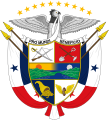Winged wheel

The examples and perspective in this article may not represent a worldwide view of the subject. (May 2024) |

A winged wheel is a symbol used historically on monuments by the ancient Greeks and Romans and more recently as a heraldic charge. The symbol was associated with the ancient Greek god Hermes. In heraldry the symbol has been used to represent transport, speed and progress. A three-winged wheel was chosen as the logo of the British Cyclists' Touring Club and at one point was considered "cycling’s most famous symbol". A two-winged version formed the logo of the London General Omnibus Company and, after a merger, formed the basis of the modern London Underground roundel.
History
[edit]
According to Eugène Goblet d'Alviella, the winged wheel is distinct from the older winged circle symbol which was commonly used in Mesopotamian and Assyrian symbolism.[1] It was used by the ancient Greeks as a symbol of Hermes, the herald of the Gods.[2] According to Goblet d'Alviella, the winged wheel was rare in Greco-Roman antiquity, and when it does appear it is mainly as an indication of a chariot or to symbolise motion:
Even the Winged Wheel, of which the symbolism of our industrial arts makes so frequent use, only appears by way of exception on Greek and Roman monuments, if we leave out the sort of velocipede on which Triptolemus rides; and even in these rare instances it appears merely as the abbreviation of a chariot, or as a symbol of motion, and in no case can it be connected with the Winged Circle which, on certain Asiatic monuments, originates in the Egyptian Globe.
— Eugène Goblet d'Alviella, The Migration of Symbols, 1894[1]
Use in heraldry
[edit]The winged wheel is used in heraldry, though plain wheels (usually cart wheels) and mill wheels are also used.[3] However, the Catherine wheel torture device is the most common wheel symbol used in heraldry.[4] The winged wheel has been shown with one, two or three wings.[5][6][7]
When included in heraldic arms they are often emblems of engineering or transport; for example in the arms of the Institution of Municipal Engineers.[8][9] However other meanings have included representing railroads, steam power, tourism, speed and progress.[10][5][11] The device has also been used to represent the Holy Spirit of the Abrahamic religions.[12]
A two-winged wheel was the logo of the London General Omnibus Company. When this company was merged into Underground Electric Railways Company of London (UERL) in 1912 the logo was combined with the "disc and bar" of the UERL to form the basis of the modern London Underground roundel.[13] A triple-winged wheel was adopted as the logo of the Cyclists' Touring Club (CTC) in 1886, possibly taking inspiration from earlier logos of the League of American Wheelmen and the Swift Cycling Club. The CTC logo quickly became "cycling’s most famous symbol", featuring on the outside of hotels associated with the CTC (known as "wheel houses") across the United Kingdom.[6]
A winged wheel symbol has been used in other contexts as various as the coat of arms of Panama and of the city of Edmonton in Canada, the flag of Knoxville, Tennessee, the badge of the Ohio State Highway Patrol, the collar badge of Polish railway troops, the emblem of Russian Railway Troops, and the logo of Rotary Watches.
The Detroit Red Wings ice hockey team has used a winged wheel in its logo since 1933, when it adopted its current name. Owner James E. Norris drew inspiration for the logo from the Montreal Amateur Athletic Association, whose athletes wore a similar design.[14]
In addition to his associations with movement and swiftness Hermes has medical associations (for example through his Caduceus staff). This led to the winged wheel's adoption by the US Army's 2nd Surgical Hospital, where it represented the unit's role in evacuating the wounded.[2]
- The three-winged Cyclists' Touring Club logo
- A winged wheel in the fourth quarter of the coat of arms of Panama
- Collar badge of Polish railway troops
- Great emblem of the Russian Railway Troops
- Logo of the Bulgarian State Railways
- Logo of the Hungarian State Railways
See also
[edit]References
[edit]- ^ a b Goblet d'Alviella, Eugène (1894). The Migration of Symbols. A. Constable & Co. p. 222.
- ^ a b Stein, Barry Jason; Capelotti, Peter Joseph (1993). U.S. Army Heraldic Crests: A Complete Illustrated History of Authorized Distinctive Unit Insignia. Univ of South Carolina Press. p. 220. ISBN 978-0-87249-963-8.
- ^ Elvin, Charles Norton (1999). A Dictionary of Heraldry. Genealogical Publishing Com. p. 133. ISBN 978-0-8063-0459-5.
- ^ Fox-Davies, Arthur Charles (2007). A Complete Guide to Heraldry. Skyhorse Publishing Inc. p. Chapter 19. ISBN 978-1-60239-001-0.
- ^ a b "About the Coat of Arms". Aberystwyth Council. Retrieved 26 February 2020.
- ^ a b "The history of the Winged Wheel". Cycling UK. Retrieved 26 February 2020.
- ^ Surveyor. 1931. p. 123.
- ^ Boutell, Charles; Brooke-Little, John Philip (1978). Boutell's heraldry. F. Warne. p. 100. ISBN 978-0-7232-2096-1.
- ^ Seeley, Ivor H. (1967). Municipal Engineering Practice. Macmillan International Higher Education. p. 7. ISBN 978-1-349-00534-5.
- ^ Meyer, F. S. A handbook of ornament. Рипол Классик. p. 114. ISBN 978-1-171-71548-1.
- ^ Fenn, Amor (1932). Design and Tradition. Prabhat Prakashan. p. 218.
- ^ Olderr, Steven (2012). Symbolism: A Comprehensive Dictionary, 2d ed. McFarland. p. 218. ISBN 978-0-7864-6955-0.
- ^ "The Roundel". Transport for London. Retrieved 26 February 2020.
- ^ "How Did They Get to Be the Red Wings?". Live About. 31 December 2018. Retrieved 25 March 2020.




